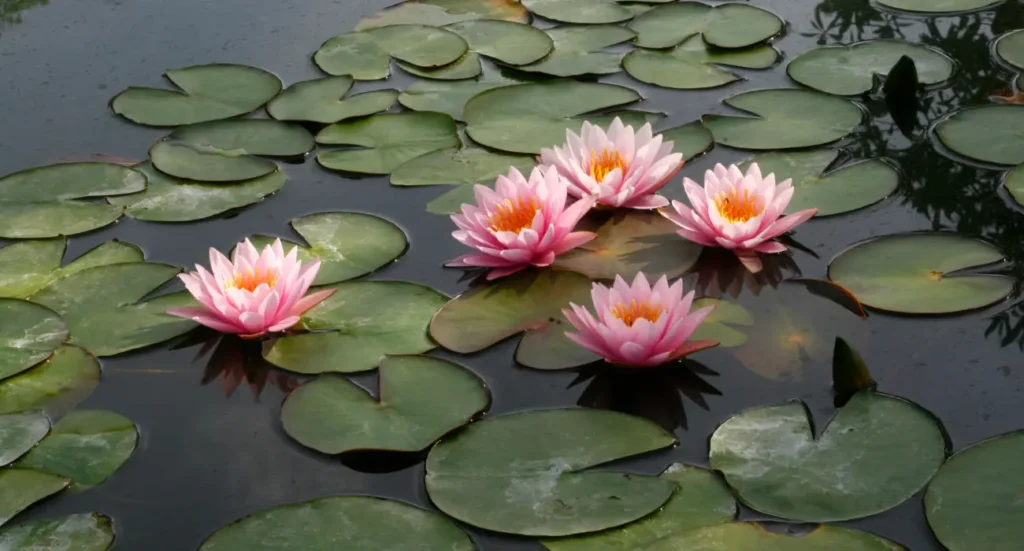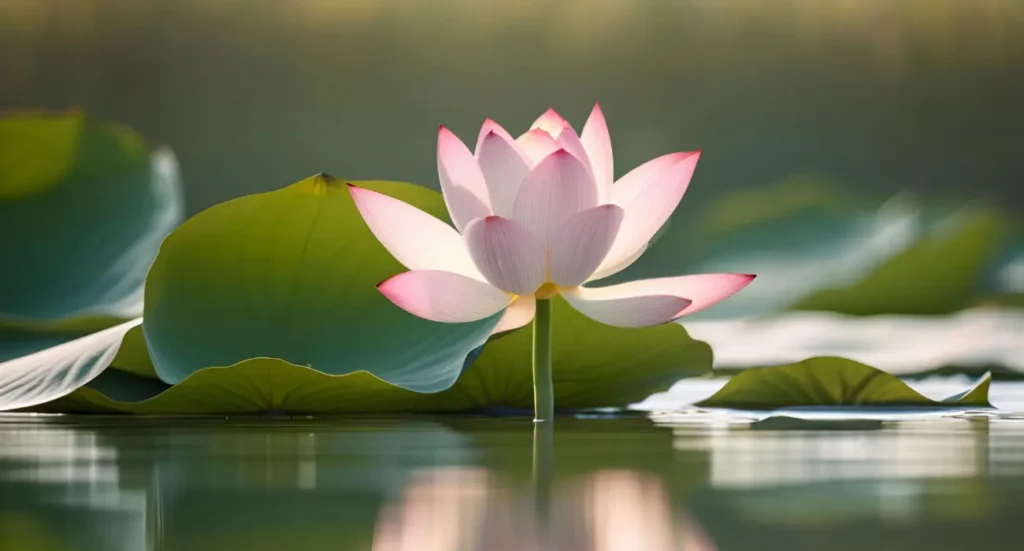Have you ever stood beside a tranquil pond and felt an overwhelming sense of peace wash over you? That magical moment often comes from witnessing the ethereal beauty of a lotus flower emerging from still waters. These remarkable aquatic plants don’t just add visual appeal to your garden – they create an entire sensory experience that touches the soul.
The lotus flower represents something far more profound than simple garden decoration. Rising majestically from muddy waters to bloom in pristine beauty, it embodies the very essence of transformation and resilience that we all seek in our own lives.
The Sacred Beauty of Lotus Flowers in Modern Gardens
The significance of the lotus flower symbolises purity, enlightenment, rebirth, and resilience. It grows in muddy waters, representing the ability to rise above challenges and transform into beauty. This powerful symbolism makes water garden design with lotus flowers more than just landscaping – it becomes a statement of hope and renewal.
When you introduce lotus cultivation into your outdoor space, you’re not merely planting flowers. You’re creating a living meditation space where ancient wisdom meets contemporary garden artistry. The gentle ripples created by lotus leaves dancing in the breeze produce a natural symphony that drowns out the chaos of modern life.
Understanding the Magnificent World of Aquatic Lotus Plants
Not all lotuses are created equal, and that’s the beauty of it. From the sizeable sacred lotus, revered in various cultures, to the petite and delicate dwarf varieties, there’s a lotus to fit any garden aesthetic. This diversity means your garden landscaping can accommodate lotus flowers regardless of space constraints or design preferences.
The sacred lotus (Nelumbo nucifera) stands as the most recognizable variety, with its large, dramatic blooms reaching up to 12 inches across. These magnificent flowers emerge in colors ranging from pure white to deep pink, creating stunning focal points in any water feature. For smaller spaces, dwarf varieties offer the same symbolic power and visual appeal while fitting perfectly into container gardens or modest ponds.
Creating Your Perfect Lotus Water Garden

Water garden design with lotus flowers requires understanding their unique growing requirements. Lotus grows best in full sun, needing at least 6 to 8 hours of daily light and warm water temperatures (between 75 and 90 degrees Fahrenheit). This knowledge becomes crucial when planning your garden layout and selecting the ideal location for your lotus pond.
The magic happens when you combine proper growing conditions with thoughtful design elements. Planting lotus flowers in a pond or water garden not only enhances the beauty of your landscape but also brings a sense of peace and serenity to your surroundings. Consider surrounding your lotus pond with natural stone borders, creating pathways that invite contemplation and quiet reflection.
Essential Elements for Successful Lotus Cultivation
Your lotus cultivation journey begins with understanding soil requirements. Growth and flowering are best when the plant is placed in rich, fertile, soft silt loam or clay soil. A mix of pine bark and topsoil provides a substrate that is a good texture for lotus culture. This foundation ensures your lotus plants receive the nutrients they need to produce those breathtaking blooms.
Water depth plays an equally important role in successful cultivation. Lotus tubers should be planted in containers submerged 12-18 inches below the water surface. This depth provides stability while allowing the distinctive leaves and flowers to emerge gracefully above the waterline, creating that iconic lotus silhouette we all recognize.
The Transformative Power of Lotus Garden Landscaping
The lotus flower is perhaps the most impressive plant in the water garden. Its beauty will amaze you throughout the warm months. This statement captures why so many garden enthusiasts consider lotus flowers the crown jewel of aquatic landscaping.
Beyond their visual impact, lotus flowers offer practical benefits that enhance your entire garden ecosystem. Their large leaves provide natural shade for fish and other aquatic life, while their root systems help filter and purify pond water. This natural filtration system reduces maintenance requirements while creating a healthier environment for all aquatic inhabitants.
Seasonal Beauty That Never Disappoints
The lotus growing season provides an ever-changing display of natural artistry. Spring brings the excitement of new shoots emerging from dormant tubers. Summer delivers the spectacular blooming period when flowers open in the early morning hours, releasing their subtle fragrance into the garden air. Autumn transforms the seed pods into architectural elements that add structure and interest even after the growing season ends.
Bringing Ancient Wisdom Into Your Modern Space
It’s often used as a symbol of purity, spiritual awakening, and enlightenment. In Hinduism, the lotus is associated with several deities, like Vishnu and Lakshmi, who are often depicted sitting on or holding the flower. In Buddhism, the lotus is symbolic of the journey to enlightenment
This rich cultural heritage adds depth and meaning to your garden landscaping choices. When friends and family gather around your lotus pond, they’re not just admiring beautiful flowers – they’re connecting with thousands of years of human spiritual tradition.
Practical Steps for Your Lotus Garden Journey

Starting your lotus cultivation adventure doesn’t require extensive gardening experience. The process involves selecting high-quality Lotus plant seeds, scarifying them to encourage germination, and soaking them in warm water until they sprout. Adequate sunlight, clean water, and proper fertilization are crucial for healthy growth.
Begin with container gardening if you’re new to aquatic landscaping. Large ceramic pots or half-barrels can house lotus plants successfully, allowing you to experiment with placement and care routines before committing to a permanent pond installation.
Designing Your Lotus Paradise
Your water garden design should complement your home’s architecture and existing landscape elements. Traditional Asian-inspired gardens pair beautifully with lotus ponds, but these versatile plants also enhance contemporary and Mediterranean-style outdoor spaces.
Consider incorporating complementary plants that thrive in similar conditions. Water lilies, cattails, and ornamental grasses create layered textures that frame your lotus flowers beautifully. Strategic lighting extends the enjoyment of your lotus garden into evening hours, when the tranquil reflections create an almost mystical atmosphere.
The Deeper Meaning Behind Your Garden Choice
The lotus flower holds various symbolic meanings that extend beyond its beauty. In many cultures, it represents purity and tranquility. The ability of the lotus to rise above muddy waters reflects the human spirit’s capacity to overcome challenges and hardships.
This profound symbolism transforms your garden into more than just an outdoor space – it becomes a daily reminder of resilience and beauty emerging from difficulty. Every morning when you see fresh lotus blooms opening to greet the sun, you’re witnessing nature’s most powerful metaphor for personal growth and transformation.
Frequently Asked Questions About Lotus Garden Design
1. How long does it take for lotus flowers to bloom after planting?
You should see sprouting in a week, roughly when growing from seeds, but expect your first blooms during the second growing season. Patience rewards lotus gardeners with increasingly spectacular displays as plants mature.
2. Can lotus flowers survive winter in colder climates?
The white lotus plant is hardy in USDA Zones 10 and 11. In colder regions, you’ll need to protect tubers by moving containers to frost-free locations or ensuring pond depth prevents freezing at tuber level.
3. What’s the best size pond for growing lotus flowers?
Lotus cultivation succeeds in ponds as small as 4 feet across, though larger water features provide more dramatic displays. The key is ensuring adequate depth (18-24 inches minimum) and sufficient surface area for leaf expansion.
Your Garden Transformation Awaits
Creating a lotus garden represents more than adopting a new landscaping trend – you’re embracing an ancient tradition that connects your outdoor space with centuries of human wisdom and natural beauty. An ideal choice for a water garden or meditation garden, water lotus, including the beloved white lotus, adds striking style with deep significance.
The journey from planning to enjoying your first lotus bloom mirrors the flower’s own emergence from muddy depths to pristine beauty. Every challenge you overcome in creating your lotus paradise – from site preparation to seasonal care – strengthens your connection to these remarkable plants and their timeless message of hope and transformation.
Your garden deserves the transformative power of lotus flowers. These magnificent aquatic plants don’t just grow in your outdoor space – they elevate it into something magical, meaningful, and eternally beautiful.

